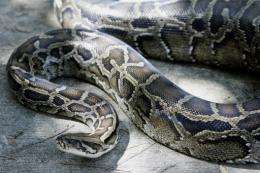Florida grapples slippery giant snake invasion

Florida homes and swamps more used to dealing with dangerous critters like alligators now face a more foreign invader -- giant pet snakes escaped into the wild whose numbers are growing at an alarming rate.
Several species of non-native snakes, such as the boa constrictor and the African python, are adapting so well to life in southern Florida's warm semi-tropical climate that they are posing a risk to wildlife and even humans.
Already well camouflaged thanks to their natural coloring, the slippery customers can glide away into the undergrowth of the Florida Everglades easily evading capture.
"Compounding their risk to native species and ecosystems is that these snakes mature early, produce large numbers of offspring, travel long distances, and have broad diets that allow them to eat most native birds and mammals," said Gordon Rodda, scientist at the Fort Collins Science Center.
In a recent report for the US Geological Survey (USGS), he highlighted that there seems to be no good way to quell the snake plague, which is beginning to sound alarm bells with local authorities, as the numbers of snakes on the loose are feared to have reached tens of thousands.
Supremely able to adapt to their environment, the boa constrictors and pythons have even begun to slip into urban environments such as Miami.
They pose the same danger as Florida's native menace, the alligator, and can attack humans even though such instances remain rare.
The snakes kill by wrapping themselves around their prey and suffocating them. In July a two-year-old toddler was strangled by a Burmese python measuring some 3.6 metres (almost 12 feet).
According to the Florida Fish and Wildlife Conservation Commission, many of the giant pests are former pets released into the wild by their owners.
But the problem could even date back to Hurricane Andrew in 1992 and Katrina in 2005 when numerous snakes escaped from their cages in zoos and pet shops amid the damage and chaos caused by the storms.
Thanks to the warm climate and vast areas of lush forests and glades, the snakes have been propagating unchecked. And they have found an ample food supply among Florida's native wildlife.
In some areas of Florida, it is possible to come face-to-face with a reticulated or regal python, which originally hails from Southeast Asia, and can grow up to six meters long (20 feet) -- making it the world's longest snake, the USGS said.
Or if that's not enough to scare you, there's always the fearsome green anaconda which can weigh up to 90 kilos (200 pounds).
"This report clearly reveals that these giant snakes threaten to destabilize some of our most precious ecosystems and parks, primarily through predation on vulnerable native species," said Robert Reed, the report's coauthor and a USGS invasive species scientist.
"We have a cautionary tale with the American island of Guam and the brown treesnake," he warned.
"Within 40 years of its arrival, this invasive snake has decimated the island?s native wildlife. Ten of Guam?s 12 native forest birds, one of its two bat species, and about half of its native lizards are gone."
Experts have examined the stomach contents of snakes which have been caught and found they have been feasting on such delicacies as bats, squirrels, lizards, iguanas -- and even alligators.
Pat Behnke, media relations officer Florida Fish and Wildlife Conservation Commission (FWC), told AFP the report was not a surprise. "We know that snakes are a problem," he said.
"We are glad that the federal government has started looking into this, we feel this is about time. No one should ever release any non-native pet into the wild, that's gonna go a long way to help this problem."
(c) 2009 AFP














